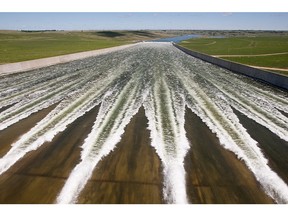“What this project needs, if federal participation is the pivot around which this will rotate, is a federal champion,” said former federal champion Ralph Goodale.

Article content
Saskatchewan’s Water Security Agency (WSA) says that while Phase 1 of the Lake Diefenbaker irrigation megaproject is moving ahead, future expansion phases may still be up in the air without federal involvement.
Put forward as a $4-billion project in 2020, the first phase of the Westside Projects is set to advance this year at a now $1.15-billion cost, without any federal commitments into the cost-share model.
Advertisement 2
Article content
Article content
The WSA says all three phases have not yet been costed out as future development on the larger Westside expansion and Qu’Appelle South Project to deliver the full 500,000 irrigable acres promised remain on tenderhooks.
“First and foremost, this project needs to be affordable for not only the provincial government but Saskatchewan producers who participate,” said a spokesperson for WSA, in an email to the Leader-Post.
“Ultimately to complete the larger vision of the project announced in 2020, we need a federal funding partner.”
In his announcement earlier in March, Premier Scott Moe said the province hasn’t received a yes or a no on its proposal to the Canada Infrastructure Bank for a joint-funding agreement, but continues to “ask and to work with” federal counterparts.
Former MP Ralph Goodale, a champion of this megaproject until his exit from office in 2019, said that five years ago there was “huge interest” from Ottawa for this idea. If that has stagnated, he suggested it may be because voices are lacking at the table.
“What this project needs, if federal participation is the pivot around which this will rotate, is a federal champion,” he said.
Article content
Advertisement 3
Article content
The new cost breaks down to about $12,000 per acre, split between the provincial government and participating producers. Details on the cost-share formula have not been worked out, but will be ready once acres come online.
Some have questioned the capital spend entirely, in relation to the number of producers it will service and whether the economic benefits are being exaggerated.
Conservationists are also concerned about the health of the lake and Saskatchewan River Basin, local habitats, and affected native grassland and wetlands inside the new irrigation zones.
Recommended from Editorial
A petition undersigned by 14 environmental groups was delivered to the federal Ministry of Environment in 2021, asking for intervention to mandate an environmental impact assessment before any of the project breaks ground.
The letter argues that public concern about the ecological harm warrants exercising of federal jurisdiction under the Impact Assessment Act.
Advertisement 4
Article content
Nature Saskatchewan executive director Jordan Ignatiuk said the answer was lukewarm, as the first phase involves infrastructure that already exists and doesn’t trigger relevant sections of the act regarding new development.
“We don’t have very much ground to stand on, environmentally, to push against it right now,” said Ignatiuk. “It is something that we’ll have to keep a close watch on.”
He said the hope is to see an assessment done before Phase 1 begins next year, and definitely before either of the next two phases commence.
Asked if an environmental impact assessment is planned, WSA said “the project is not yet at a stage where we have enough information to start the environmental assessment process.”
“The Government of Saskatchewan is committed to following the process and ensuring the environment is protected and considered in the project.”
In the last four years, engineering consultants have completed a preliminary design report including bathymetric and topographical analysis around the project area, soil evaluation, water modelling, geotechnical and hydrological investigation, and a baseline assessment of select affected plants, animals and water quality.
Advertisement 5
Article content
This report also includes initial concept viability, including pump station size, canal routing and reservoir locating necessary to service the Westside expansion.
Over the next year and a half, engineering, design and engagement with Indigenous stakeholders is to take place. SaskBuilds is engaged for procurement, said WSA.
Should phases 2 and 3 be delayed, WSA says it will continue working to find “affordable ways to advance the same number of irrigated acres from Lake Diefenbaker” in the interim.
“It may be through smaller projects over time but will achieve the same goal,” said the WSA.
Article content






